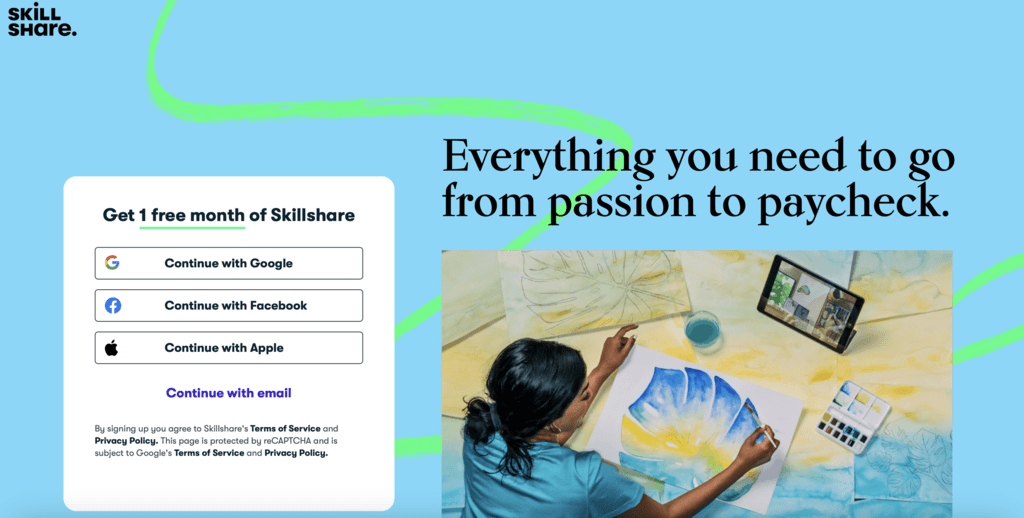How Much Money Can You Make From Online Courses?
The amount of money you make from selling your online course can vary depending on the length of your course, your expertise, your target audience, and more. However, the average earnings range for successful course creators is between $1,000 and $10,000 per month. For the top course creators, it's not uncommon to earn as much as $6,000 and $7,000 per month! That said, don't expect to start earning these amounts right away, as it takes a lot of research, effort, and marketing to reach these numbers.
How to Create and Sell an Online Course
Choose Your Topic
Choosing a topic is the first step in creating a successful tutoring course, so be sure to choose a topic that aligns with your existing skills or knowledge. Focusing on an area of expertise helps build trust with students and ensures that you are providing the best service possible. In addition, demonstrating that you have this particular knowledge is invaluable in attracting clients, especially if it is backed by certifications or degrees.
A final important factor to make sure of when choosing the topic is having a genuine interest in the subject matter. This is because the process of researching and creating the course can be time-consuming and requires dedication from the start.

Research the Market
Once you have confirmed your course subject, you'll want to do some research to see if it's a topic that's in high demand. There are several ways to research whether your course is in demand:
- Search for your topic on Google Keyword and Google Trends: Checking if your course topic has a high search volume indicates that there is strong interest and demand for it.
- There are other courses on your topic: While too much competition isn’t ideal, existing courses on your topic can signal strong demand.
- Take your research to forums: Forums like Reddit and Quora are useful for asking questions or running polls to see if your course would be appealing to the public.
- Check out online course platforms: If there are a lot of courses on the same topic currently online, it could indicate that your topic is in high demand. Reading reviews can also help you understand what people enjoy or find lacking in other courses, too.
Understand Your Audience
Before you start putting together the content for your course, you'll also need to work out who your audience is and who you're speaking to. You could consider age, interests, occupation, professional background, and other personal details, depending on your topic. Once you've got this figured out, consider looking into their learning goals, needs, and preferences to make sure you're putting together the best course you can. To do that, you could:
- Set up a Google Form and share it on social media, including questions to get a better understanding of your audience.
- Check out social media, forums, blogs, and podcasts to see what people are saying about your topic online and if there are any issues they're facing.
- Set up phone or video interviews with some willing participants.
- You could even try out a short, free online mini-course to see if it catches on before you go ahead with the full thing.

Establish Your Course Outcomes
Once you know who your audience is and what they want to get out of the course, it's time to lay out the objectives and outcomes. Customers want to know that, if they buy and complete your course, they will be able to fulfill a certain goal they have. For instance, if your course is on dog grooming, your goal might be for your students to be able to groom their first dog after finishing your course.
Research Your Topic
Even if you're already familiar with your subject, it's still a good idea to do some thorough research before creating your course. This is probably the most time-consuming part of the whole process, as all the information you share must be accurate, relevant, and up-to-date.
In addition, it's a good idea to focus on the pain points and subtopics your audience mentioned during your research. This will help you provide information they really want to learn. Using a variety of different sources, such as articles, videos, academic papers, podcasts, and more, will ensure you have good coverage of your topic.
Build Your Course Structure
Building your course structure is an essential step to determine what each lesson and module of the course will cover. It's important to put yourself in your students' shoes: if your course is for beginners, start with the most basic information and build from there. You should also set clear objectives for what they should have learned by the end of the lesson. For example, if your course is about learning to bake a cake, you might have a lesson plan like:
- Basics of Baking
- Mixing and Baking
- Cooling and Decorating
The number of lessons depends on whether you are creating a short, mini, or long course, so you may be able to go into more detail and add more subtopics. Or, if your course is for more advanced learners, you could divide the topics further:
- Ingredient Functions
- Mixing Methods
- Advanced Cake Decoration
Select Your Course Platform
Fortunately, there are numerous different platforms to help you create and sell an online course. However, with so many options, it's important to consider a few features of each platform before making a decision:
Easy-to-Use
A simple and straightforward platform with handy drag-and-drop tools, easy uploads, and navigation may be preferable, especially if this is the first course you've created. Platforms like Thinkific and Teachable pride themselves on being very user-friendly.
Platform Reach
Choosing a platform with a large audience and reach could mean that your course is more likely to sell and become popular. Well-known platforms with large audiences include Skillshare, Udemy, Thinkific, and Teachable, although keep in mind there may be more competition.
Marketing Capabilities
Some platforms have built-in marketing tools to help you promote your course as widely as possible, including Kajabi, Podia, Skillshare, and Udemy.
Analysis
In order to continually improve your course and understand its strengths and weaknesses, analytics and reporting can be essential tools. Platforms like Teachable and Skillshare offer built-in tools to support this.
- Easy-to-use: Thinkific, Teachable
- Largest Audience: Skillshare, Udemy
- Best for Marketing: Kajabi, Podia

Create the Course Content
Using your lesson plan, you can start to build out your course content, drawing on your audience and content research. You should aim to present your information using a variety of different methods and sources to keep your audience engaged like videos, case studies, quizzes, eBooks, and more.
Tools like Canva, Audacity, Google Docs, Vimeo, and Quizlet, along with any built-in programs on your course platform, can make your course look and feel professional and enhance the learning experience.

Edit and Review
Editing and reviewing your course content is the final step in making sure your course is ready to publish. Getting rid of fluff like language or information, checking spelling and grammar, making sure all your information is accurate and relevant, and that there's a good flow and cohesion from lesson to lesson will greatly improve your course.
Set Your Pricing
The price of your course depends on several factors, including whether it's a one-day course, a one-week course, or a full master class. However, consider competitive pricing to avoid deterring potential students by checking out similar courses in the field. This can help you figure out the average cost and make sure your pricing is in line with what people expect.
Most online courses are offered as either a one-time payment or a subscription, and each has its own advantages. The one-time payment works well for single courses, while a subscription is better for those with multiple offerings, giving students access to a range of content.
On top of that, having the right expertise is also a big factor in pricing. The right accreditation and certification makes the course information more valuable and justifies higher prices. It's also smart to think about how much it costs to make the course, including time spent on recording, filming, and editing to ensure a profit.
Launch and Promote Your Course
Once the course is launched, it's important to promote it. Use marketing tools and techniques such as email marketing, social media, Google and Facebook ads, affiliate marketing, blogging, and search engine optimization (SEO) to create buzz and build awareness.
In addition, sending a follow-up email thanking customers for their purchase and asking for a good review is a great way to build trust and attract more potential customers.
Gather Feedback and Analyse
It's vital to get feedback from your students and look at any improvements you can make to your course to increase its chances of success. To do so, you can create a form and survey for students to complete at the end of the course to find out what they thought went well and what problems they encountered.
If your chosen platform has built-in analysis tools, you can also track student activity and attendance. As well as this, you can measure how many assignments they complete, and other user behavior to see what else you can improve. If a particular assignment hasn't been completed by many students, it might be time to give it a refresh or make some edits.

Conclusion
In summary, creating and selling online courses lets you use your expertise to help eager learners and offers great financial rewards. By taking the time to thoroughly research your topic, create high-quality content, gather feedback, and continually refine your materials, you can create engaging courses. These efforts will ensure that your courses effectively connect and resonate with learners. Who knows, your course could even become your main source of income, or at the very least, a nice bit of extra cash on the side.




